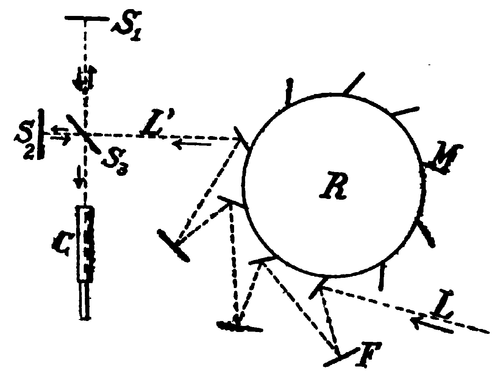reflected light is variable (and equal to the sum of c = 3.1010cm. and the component of the velocity of the image in the direction of the ray) we shall have
And since c' = n'λ' and c = nλ we have λ' = λ. It remains then to see by experiment whether or not we can observe, in addition to the Doppler effect, a variation in the value of λ; from this we can ascertain whether c remains constant or not on reflexion from a moving mirror. I have not proceeded to the observation of the Doppler effect in these researches since there is no doubt about its existence, already proved experimentally by the authors quoted; I have rather sought to find out whether and in what way λ varies when the velocity of the moving mirrors changes.
Belopolski's arrangement for the study of the Doppler effect was inconvenient on account of the excessive subtility of the luminous ray necessary to obtain multiple reflexions from the same mirrors; for this reason the author mentioned was unable to observe the displacement of the rays except by photography. I prefer to adopt the arrangement shown diagrammatically in fig. 2. A horizontal brass wheel R, 35 cm.

in diameter (6 mm. thick), which can be made to revolve with a maximum velocity of 80 turns per second, bears on its periphery ten mirrors similar to M, rectangular, plane, vertical, of glass silvered at the back. The velocity of the centres of the mirrors, corresponding to the greatest velocity of rotation, amounts therefore to more than 100 metres per

